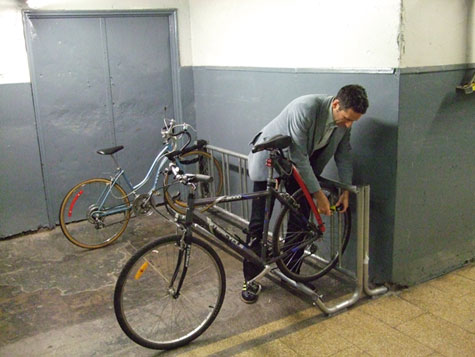Indoor Bike Parking: How to Get It Done
Eliza Gray files this report for Streetsblog.

Adam Mansky locks up at the new rack in his office building. Photo: Gene Sorkin / PicNY.com.
The Bikes in Buildings Bill still awaits a hearing in City Council, while building managers weigh whether to voluntarily provide bike access and parking. Thankfully, not everyone is hesitating. Here’s how one New York office building just got friendlier for bike commuters, going beyond access by giving tenants a place to lock up.
Last month, Newmark Knight Frank, a real estate and property management firm, installed an indoor bike rack at 520 Eighth Avenue, a corporate office building that serves 86 businesses and 5,000 employees.
Adam Mansky, a tenant who works at the Center for Court Innovation, asked building manager Peter Troisi if the building should install a bike rack. "I told him I would look into it," Troisi recalls.
Troisi called Eric Gural, the Executive Managing Director at Newmark who is in charge of running the building, and the two agreed that the rack was a good idea.
"Riding bikes to work is a good thing, and we want to support that," Gural explains. "It would not be the same if tenants asked for a free candy machine."
"It was simple," Troisi said. "We ordered it from a catalogue, it came in four weeks, and we installed it ourselves." The rack, which cost $600 and holds ten bikes, is located in the freight entrance to the building. According to Troisi, four to five commuters use the rack every day. If demand increases, says Gural, Newmark will happily install another one.
"Some buildings might say, ‘We have 5,000 tenants, and we are only helping five so it is not a big enough impact,’ but we don’t see it that way," says Gural. "If it had impacted other tenants’ ability to get freight we would not have installed it, but that was not the case."
The building has long accommodated bike commuters; before the rack was installed, tenants could bring bikes up the freight elevator and store them in their offices. Now commuting is more convenient because tenants can drop their bikes in the rack and ride the passenger elevator instead waiting for the freight elevator.
Mansky, who has been commuting for 18 months, says the building’s accommodations have made all the difference. "I have been able to convince a few of my colleagues to commute with me, partly because I tell them they won’t have to leave their bikes outside," he says.
Installing a bike rack into a corporate building is not as simple as it sounds. "It is not as easy as putting a bike rack into your house," says Gural. "The key is cooperation from everyone involved." The building owner, building manager, and management company have to agree. Consensus was relatively easy at 520 Eighth avenue because Newmark both owns and manages the building.
520 Eighth Avenue also had the advantage of good space and security, which some corporate buildings lack. There was space for a rack in the large freight entrance that does not take in as much freight as it used to, and the existing security camera reduced worries about liability.
The good news is that Newmark will probably install bike racks in more buildings. Gural has started LEED (Leadership in Energy and Environmental Design) certifications in all the buildings he manages — a certification from the U.S. Green Building Council awarded to buildings that meet the highest green standards. By installing a bike rack, buildings earn points toward the minimum number required to get a LEED certification.
In the meantime, the tenants at 520 Eighth avenue could not be happier. Mansky applauds the efforts of Troisi and his staff. "I feel totally welcomed," he says. "It makes my commute that much easier and more fun."





